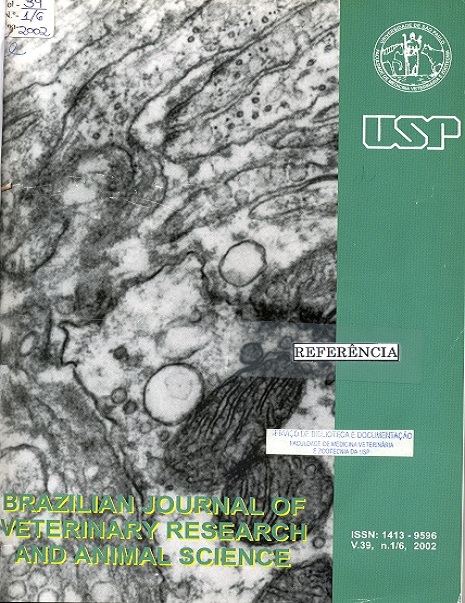Application of direct immunofluorescence technic for the diagnosis of canine visceral leishmaniasis in lymph nodes aspirate
DOI:
https://doi.org/10.1590/S1413-95962002000200009Keywords:
Immunofluorescence, Visceral leishmaniasis, Lymph nodes, DogsAbstract
Recently, canine visceral leishmaniasis (CVL) was detected in the northwest of São Paulo State - Brazil. The Veterinary Hospital - UNESP - Araçatuba, in 2.000, carried out 60 cytopathological test of suspected cases of leishmaniasis using the fine-needle aspiration (FNA). The smears of the FNA popliteal lymph nodes were stained by the Romanowsky stain (Diff-Quik®) and observed using a light microscope. The positive cases showed typical amastigotes forms of Leishmania either free or in macrophage vacuoles. Cytopathological signs of reactivity of the lymph-hystiocitary system with the absence of parasites were also detected. In order to improve the diagnosis of CVL, looking for parasites and antigenic material detection in smears, we standardized the direct immunofluorescence assay (IFD) using mouse anti-Leishmania policlonal antibodies. We compared the IFD assay with the direct search of parasites in smears stained by Romanowsky stain. From the 60 dogs with clinical signs of the disease, the direct exam was positive in 50% (n=30), uncertain in 36,7% (n=22) and negative with lymph node reativity in 13,3% (n=8). When the lymph node smears were submitted to IFD assay we observed positive reaction in 93,3% (n=56) and negative reaction in 6,7% (n=4). Our results showed that IFD assay presented a high sensibility compared to parasite direct search by Romanowsky stain. The IFD assay could be useful method to confirm the uncertain cases of the disease, where amastigotes forms were not clearly identified.Downloads
Download data is not yet available.
Downloads
Published
2002-01-01
Issue
Section
UNDEFINIED
License
The journal content is authorized under the Creative Commons BY-NC-SA license (summary of the license: https://
How to Cite
1.
Moreira MAB, Luvizotto MCR, Nunes CM, Silva TCC da, Laurenti MD, Corbett CEP. Application of direct immunofluorescence technic for the diagnosis of canine visceral leishmaniasis in lymph nodes aspirate. Braz. J. Vet. Res. Anim. Sci. [Internet]. 2002 Jan. 1 [cited 2025 Dec. 30];39(2):103-6. Available from: https://revistas.usp.br/bjvras/article/view/5989





